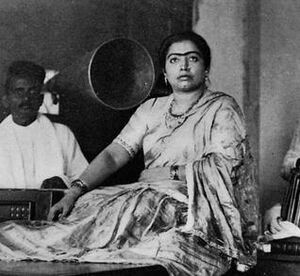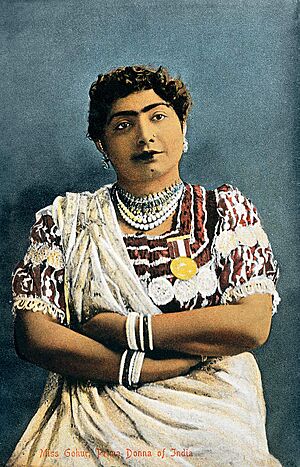Gauhar Jaan facts for kids
Quick facts for kids
Gauhar Jaan
|
|
|---|---|
 |
|
| Background information | |
| Birth name | Angelina Yeoward |
| Born | 26 June 1873 Azamgarh, North-Western Provinces, British India |
| Died | 17 January 1930 (aged 56) Mysore, Kingdom of Mysore, British India |
| Genres | Ghazal, thumri, dadra |
| Occupation(s) | Musician, dancer |
| Years active | 1887–1930 |
Gauhar Jaan (born Angelina Yeoward; 26 June 1873 – 17 January 1930) was a famous Indian singer and dancer. She was born in Azamgarh but became well-known in Kolkata.
Gauhar Jaan was one of the first artists in India to record music. Her songs were put on special records called 78 rpm records. The Gramophone Company of India released her music. This made her famous as "the Gramophone girl" and "the first recording superstar of India." She recorded over 600 songs in more than ten languages. She helped make Hindustani classical music styles like thumri and dadra very popular.
Early life
Gauhar Jaan was born on June 26, 1873. Her birth name was Eleen Angelina Yeoward. She was born in Azamgarh, India. Her father, Robert William Yeoward, was an engineer. Her mother, Adeline Victoria Hemmings, was a talented musician and dancer.
In 1879, her parents separated. Angelina and her mother moved to Banaras in 1881. There, Victoria met a nobleman who loved her music. Later, Victoria became a Muslim and changed her name to 'Malka Jaan'. Angelina's name was changed to 'Gauhar Jaan'.
Career
Malka Jaan became a very skilled singer and Kathak dancer in Banaras. She was known as Badi Malka Jan. This meant 'elder Malka Jan' because other famous singers also had that name.
In 1883, Malka Jaan moved back to Kolkata. She became a performer in the court of Nawab Wajid Ali Shah. Young Gauhar began her music and dance training there. She learned Hindustani classical music from famous teachers like Kale Khan and Ustad Ali Baksh Jarnail. She also learned Kathak dance from Brindadin Maharaj. Gauhar Jaan even started writing her own songs, called ghazals. She used the pen-name 'Hamdam'.
Gauhar Jaan gave her first public performance in 1887. This was at the royal court of Darbhanga Raj. She was then hired as a court musician. By 1896, she was performing regularly in Kolkata. She was known as the 'first dancing girl' in her records.
Around 1904, she met a theatre artist named Amrit Keshav Nayak. He helped her during a difficult time after her mother passed away.
In 1910, Gauhar Jaan performed in Madras. Her songs were even printed in a Tamil music book. In December 1911, she was invited to sing for King George V. This was at a special event called the Delhi Durbar. She sang a duet with another singer, Jankibai of Allahabad.
Later in her life, she moved to Mysore. She was invited by Krishna Raja Wadiyar IV, the ruler of Mysore. On August 1, 1928, she became a 'Palace musician'. She passed away in Mysore on January 17, 1930.
During her career, Gauhar Jaan recorded over 600 songs. She sang in more than ten languages. These included Bengali, Hindustani, Tamil, and French. She would always end her recordings by saying, "My name is Gohar Jan."
She made Hindustani classical music popular. She was especially known for her thumri, dadra, and kajri songs. She was very skilled at making long classical songs fit into short recordings. Her most famous songs include Mora nahak laye gavanava and Radhey Krishna Bol Mukhse.
India's first recording sessions
Gauhar Jaan was part of India's very first music recording sessions. These began on November 8, 1902. Fred Gaisberg from the Gramophone Company recorded her. She sang a khayal in Raag Jogiya.
Over six weeks, more than 500 recordings were made of local artists. The records were made in Germany. They arrived in India in April 1903. These recordings were a huge success. They helped make the gramophone popular in India. The recordings were done in a hotel in Kolkata. By 1903, her records were in high demand.
Honors and legacy
It is said that the famous singer Begum Akhtar was inspired by Gauhar Jaan. After hearing Gauhar and her mother sing, Begum Akhtar decided to focus on Hindustani classical music.
On June 26, 2018, Google honored Gauhar Jaan with a special Google Doodle. This was for her 145th birthday. Google said she helped shape the future of Indian performance art.
Her songs are also part of a music album called 'Vintage Music From India'. This album was released in 1996. Her picture is on the cover of this album.
Saregama India (formerly His Master's Voice or HMV) is working to restore her old recordings. They are getting them from the Gramophone Company's archives in London. They want to bring these important recordings back to life.


